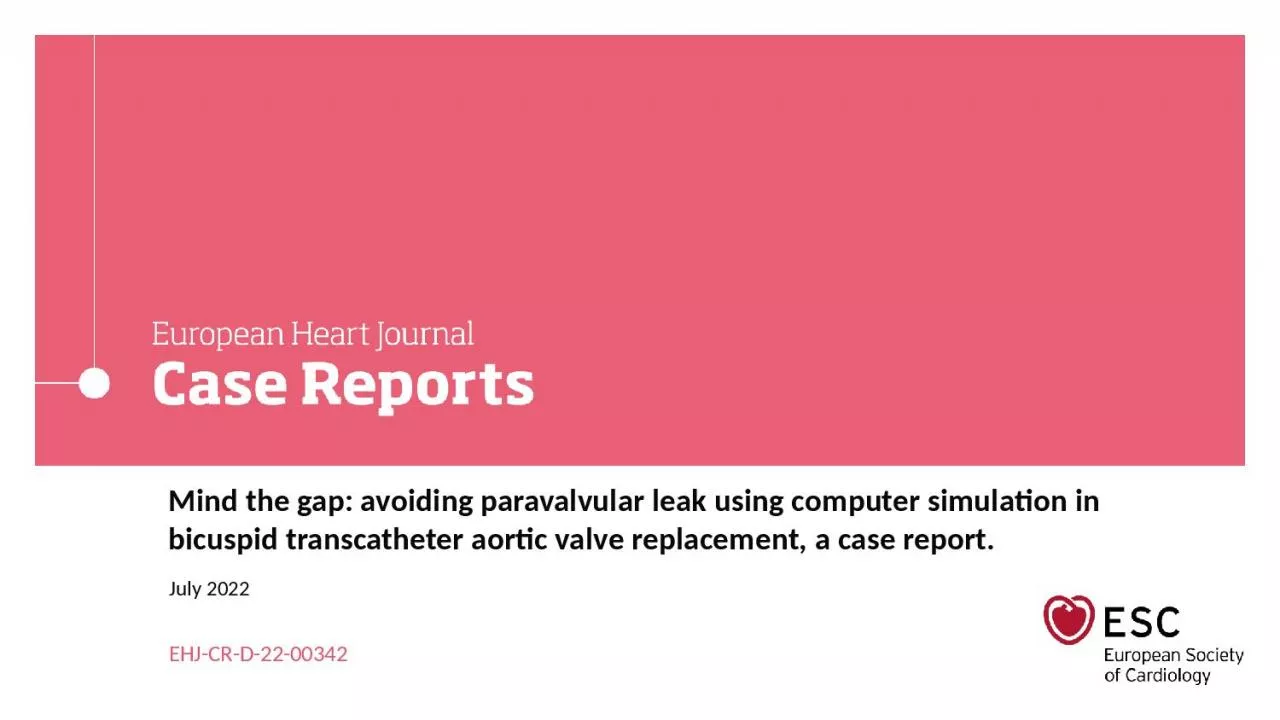

EHJCRD2200342 July 2022 Introduction EHJCRD2200342 2 Transcatheter aortic valve replacement TAVR is becoming increasingly prevalent worldwide In 2019 the number of TAVR performed in the USA exceeded surgical aortic valve replacements SAVR 72991 vs 57626 ID: 1037110
Download Presentation The PPT/PDF document "Mind the gap: avoiding paravalvular leak..." is the property of its rightful owner. Permission is granted to download and print the materials on this web site for personal, non-commercial use only, and to display it on your personal computer provided you do not modify the materials and that you retain all copyright notices contained in the materials. By downloading content from our website, you accept the terms of this agreement.
1. Mind the gap: avoiding paravalvular leak using computer simulation in bicuspid transcatheter aortic valve replacement, a case report. EHJ-CR-D-22-00342July 2022
2. IntroductionEHJ-CR-D-22-003422Transcatheter aortic valve replacement (TAVR) is becoming increasingly prevalent worldwide. In 2019 the number of TAVR performed in the USA exceeded surgical aortic valve replacements (SAVR), 72,991 vs 57,626.1 10% of those undergoing TAVR have bicuspid aortic valve (BAV).2 Therefore large numbers of BAV TAVR are being performedBAV associated with increased risk of complication – severe paravalvular leak (PVL), cerebral ischaemic events and annular rupture.3BAV poses increased complexity due to anatomical heterogeneity. This leads to difficulty in accurate valve sizing.
3. Case PresentationHistory and Examination FindingsEHJ-CR-D-22-00342386 year old female admitted with progressive dyspnoea, NYHA IV, reducing exercise tolerance and syncope. Past medical history of breast cancer, hypothyroidism and osteoarthritis. She is an ex-smoker. On examination has both pulmonary and peripheral oedema, ejection systolic murmur and no second heart sound. Treated with intravenous diuretics with good effect.
4. Case PresentationInvestigationsEHJ-CR-D-22-003424ECG: Sinus rhythm with normal PR interval and narrow QRSNew diagnosis made of severe aortic stenosis and impaired left ventricular function, EF 40%. Peak gradient 71 mmHg, Mean gradient 43 mmHg.
5. Case PresentationInvestigationsEHJ-CR-D-22-003425Panel A Showing calcified Sievers Type 1 BAV with R-L fusion. The annular perimeter is 82.9mm. (Figure 1) There was a derived annular diameter of 26.4mm, a sinus of Valsalva diameter of 34.4mm and a sino-tubular junction height of 21.2mm Panel B shows the hockey puck virtual reality reconstruction of valvular structure and calcification, note the valve is inverted therefore the right and left coronary cusps are inverted between images.
6. Case PresentationManagementEHJ-CR-D-22-003426Discussed in Heart Team – best option would be TAVR rather than surgery, should a good result become available.Feops HEARTguide used for pre-procedural patient specific computer simulation.Initially poor results with Evolut PRO 29 mm and Evolut R 34mm in both high and medium position.Re-modelled with new Evolut PRO+ 34 mm with good result in medium position.
7. Case PresentationManagementEHJ-CR-D-22-003427Demonstrating the 6 modelled scenarios. The 3 valves; Evolut 29 PRO, Evolut 34R and Evolut 34 PRO+ in both high and medium positions with the associated predicted paravalvular leak in millilitres per second. A more than mild paravalvular leak is predicted in greater than 16ml/s. This demonstrates the Evolut 34 PRO+ has the lowest amount of predicted paravalvular leak.
8. Case PresentationManagementEHJ-CR-D-22-003428Decision to proceed with 34 mm Evolut PRO+ valve3x recapture-redeployments required to place accurately. Deployed at 3mm below NCC.Result of angiographically mild PVL.Echo showed mild-moderate PVL.No ECG changes or rhythm disturbance8 weeks post procedure patient had resumed usual activities and routine with no breathlessness or oedema.
9. Case PresentationManagementEHJ-CR-D-22-003429Panel A demonstrates valve positioning during deployment. Panel B demonstrates the fully deployed valve and mild paravalvular leak seen during aortography AB
10. DiscussionEHJ-CR-D-22-0034210Multiple published and well-used algorithmic approaches exist including Calcium Algorithm Sizing for bicusPid Evaluation with Raphe (CASPER), supra-annular Bicuspid Aortic Valve anatomy and Relationship with Devices (BAVARD) and Level of Implantation at the RAphe (LIRA).(4-6)Using these algorithms would yield results of 34 mm, 29 mm and 29 mm respectively
11. DiscussionEHJ-CR-D-22-0034211Without the guidance provided by modelling, it is likely that this patient would have undergone implantation of the Evolut R 34 mm valve. If the model is correct the patient may have had significant aortic regurgitation and a sub-optimal TAVI outcome. The model in this case has been shown to be safe and to accurately predict the result in a difficult, severely calcified BAV. The additional information provided with modelling could allow for a more patient-specific, tailored discussion at Heart Team meetings.
12. Learning PointsEHJ-CR-D-22-0034212Determining the correct TAVR valve size is integral in ensuring a good outcome. Patient specific simulation modelling can assist in this.There are several accepted methods for valve sizing in bicuspid aortic valve; the CASPAR, LIRA & BAVARD methods. We demonstrate the use of patient-specific pre-procedural modelling which may have advantages over algorithm-based methodology to achieve the best result in an individual patient.
13. ReferencesEHJ-CR-D-22-0034213Carroll JD, Mack MJ, Vemulapalli S, Herrmann HC, Gleason TG, Hanzel G et al. STS-ACC TVT Registry of Transcatheter Aortic Valve Replacement. J Am Coll Cardiol. 2020 Nov 24;76(21):2492-2516. Kim W.K., Liebetrau C, Fischer-Rasokat U, Renker M, Rolf A, Doss M et al, Challenges of recognizing bicuspid aortic valve in elderly patients undergoing TAVR. Int J Cardiovasc Imaging. 2020 Feb;36(2):251-256.Montalto C, Sticchi A, Crimi G, Laricchia A, Khokkar A, Giannini F et al. Outcomes after transcatheter aortic valve replacement in bicuspid versus tricuspid anatomy. JACC: Cardiovascular Interventions. 2021 October, 14(19) 2021:2144 – 2155Petronio AS, Angelillis M, De Backer O, Giannini C, Costa G, Fiorina C et al, Bicuspid aortic valve sizing for transcatheter aortic valve implantation: Development and validation of an algorithm based on multi-slice computed tomography. J Cardiovasc Comput Tomogr. 2020 Sep-Oct;14(5):452-461. Tchetche D, de Biase C, van Gils L, Parma R, Ochala A, Lefevre T et al. Bicuspid Aortic Valve Anatomy and Relationship With Devices: The BAVARD Multicenter Registry. Circ Cardiovasc Interv. 2019 Jan;12(1):e007107Iannopollo G, Romano V, Buzzatti N, Ancona M, Ferri L, Russo F et al. Supra-annular sizing of transcatheter aortic valve prostheses in raphe-type bicuspid aortic valve disease: The LIRA method, Int J Cardiol. 2020 Oct 15;317:144-151.